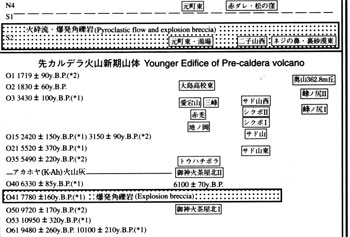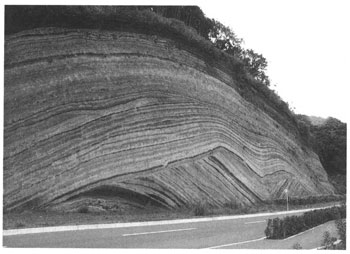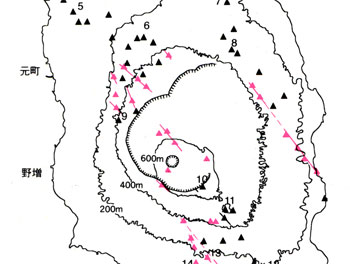Izu-Oshima Volcano
1: Introduction / Topography of Izu-Oshima
2: Geology of Izu-Oshima Volcano
3: Rocks of Izu-Oshima Volcano
4: Historical outline of Izu-Oshima Volcano after the formation of caldera
5: Activities after 19th century
6: Monitoring / Points to be watched for disaster prevention
7: References
![]() PREV
PREV ![]() NEXT
NEXT
Geology of Izu-Oshima Volcano
Early volcanoes
On the sea cliffs from north to east coast of the island are exposed remnants of three stratovolcanoes. Those are named from north, Okata Volcano, Gyoja-no-Iwaya Volcano, and Fudeshima Volcano. The ages of those are not clear yet, but estimated to be from Late Pliocene to Pleistocene. Okata Volcano is intermittently exposed on the sea cliffs from west of Okata Harbor to Chichigasaki Promontory and mainly composed of basaltic lava flows, pyroclastic rocks, and dikes. Gyoja-no-Iwaya Volcano is exposed on the eastern sea cliffs south of Oshima Park as several thick basaltic lava sheets intercalated with thin pyroclastic layers. Fudeshima Volcano is exposed on the sea cliffs on the opposite side of Fudeshima Islet further south of Gyoja-no-Iwaya Volcano, and consists of basaltic lava flows, pyroclastic rocks, and many dikes. The Fudeshima Islet is identified as vent breccia resistant to erosion of the sea. The interrelations among those earlier volcanoes are not known.
Izu-Oshima Volcano
Izu-Oshima Volcano consists of pre-caldera volcano, and syn- and post-caldera volcano.
Pre-caldera Volcano started its activity on the sea floor about 30 to 40 thousand years ago. The ejecta at this stage were mostly coarse-grained pyroclastic materials with little basaltic lava flows and pyroclastic fall deposits. Those ejecta created pre-caldera and older volcanic body ( Senzu Formation ). The deposits belonging to this stage are mainly exposed in north and east sea cliffs with little exposures in SW sea cliffs.
Pre-caldera stage younger volcanic body ( Older Oshima Formation ) started about 20 thousand years ago. Thick deposits cover pre-caldera older volcanic deposits. The younger deposits are mainly scoria fall deposits and lava flows representing comparatively quiet mode of activity as compared to the older volcano stage. On the ' Senba Stratum Section ' ( ![]() Fig. 1 ) along the road in the SW of the island, about 100 beds belonging to younger volcano stage are well exposed. Average interval of successive eruptions represented by each bed is understood to be 150 years or so. Some beds contain pisolites and angular fragments reflecting large-scale phreatic explosions at the summit.
Fig. 1 ) along the road in the SW of the island, about 100 beds belonging to younger volcano stage are well exposed. Average interval of successive eruptions represented by each bed is understood to be 150 years or so. Some beds contain pisolites and angular fragments reflecting large-scale phreatic explosions at the summit.
Caldera
Judged from mutual relationship of caldera walls, the current caldera was formed by the combination of at least four ring structures. The final shape was determined about 1,300 to 1,500 years ago by explosive eruption which occurred at the summit. Similar deposits related to younger volcanic body are identified in O41 member ( about 7,800 years old ) suggesting that similar activity had occurred before. The caldera wall on the east side is completely obscured being buried by later deposits, but original caldera rim can be inferred from the distribution of drainage pattern.
Parasitic volcanoes
Over eighty parasitic volcanoes are identified ( ![]() Fig. 2 ). Other topographic features suggestive of parasitic volcanoes exist, but those cannot be identified as such with confidence as they are overlain by thick ash fall deposits. Most of the parasitic volcanoes are scoria cones such as Take-no-hira and Hachi-no-Shiri accompanying lava flows and often aligned along fissures from which eruptions occurred. For those below 100 m a.s.l. and close to the shoreline, explosion craters and tuff rings may be observed from phreatomagmatic explosions resulting from contact of magma and sea water.
Fig. 2 ). Other topographic features suggestive of parasitic volcanoes exist, but those cannot be identified as such with confidence as they are overlain by thick ash fall deposits. Most of the parasitic volcanoes are scoria cones such as Take-no-hira and Hachi-no-Shiri accompanying lava flows and often aligned along fissures from which eruptions occurred. For those below 100 m a.s.l. and close to the shoreline, explosion craters and tuff rings may be observed from phreatomagmatic explosions resulting from contact of magma and sea water.
Because of the distribution of parasitic volcanoes concentrating in NNW-SSE, the outline of the island is elongated in this direction. The direction is matching to that of maximum compressive stress in this region as deduced from focal mechanism of the earthquakes. It is interpreted that the region is compressed in NNW-SSE direction producing fissures parallel to this direction into which upcoming magma can intrude.


